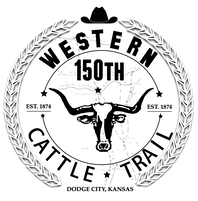Books & Articles on the Cattle Trails
The following books are some of the best known readings about the early trail drives and are free for downloading and your enjoyment. These books are some of the references used to portray the stories outlined on this Website and are useful to those who are interested in learning more about the individuals who ventured onto the cattle trails of the early 1800’s.
|
These are the chronicles of the trail drivers of Texas those rugged men and, sometimes, women who drove cattle and horses up the trails from Texas to northern markets in the late 1800s. Gleaned from members of the Old Time Trail Drivers' Association, these hundreds of real life stories some humorous, some chilling, some rambling, all interesting form an invaluable cornerstone to the literature, history, and folklore of Texas and the West.John Marvin Hunter (March 18, 1880 – June 29, 1957) was an author, historian, journalist, and printer who founded the Frontier Times Museum in Bandera, Texas. The museum, which contains about 40,000 artifacts of the American West, opened in 1933, It is named for Hunter's Frontier Times magazine, which was first published in 1923.
|
|
In 1909, former frontier judge and editor Edgar Rye introduced The Quirt and the Spur: Vanishing Shadows of the Texas Frontier to a reading public hungry for stories of this vanishing world. Drawing upon his experiences during the frontier’s heyday, Rye focused on the area around old Fort Griffin during the 1870s, a time and place that was fast fading from memory. At the heart of the narrative stood The Flat, a wild yet vibrant frontier village attached to the fort. Peopled by the desperate and the hopeful, the adventurous and the opportunistic, The Flat was a place in the tradition of Dodge City and Tombstone, towns that became synonymous with western violence and lawlessness. More than any other single work of western Texas historiography, The Quirt and the Spur helped shape the perception of Old Northwest Texas as a wild and woolly frontier.
|
|
The Log of a Cowboy brings to life an important, yet short-lived, piece of the American Old West. It’s here that the cowboy earned his reputation and admiration, and it’s through protagonist Tommy Moore that we learn of some of the challenges of the legendary cattle drive. Run-ins with Indian tribes, cattle hustlers, shoot-’em-ups, and the lure of “good whiskey and bad women,” are just some of the troubles that Moore faces, all told with that classic cowboy swagger.
It’s not just the thrill of adventure that makes this such a fascinating tale; The Log of a Cowboy is often seen as a narrative of Andy Adams’s own life after twelve years in the saddle, and although some liberties were taken, it remains one of the most reliable accounts ever written, helping cement the lawless, and revered, Wild West into a national subconscious. Through Moore we learn cowboy colloquialisms like “drifting” and “cutting,” the perils of stampedes, and the innate intuition of these frontier men. |
|
Born in Virginia, Reed Anthony serves in a regiment of his home state during the Civil War before travelling to Texas to take up the hard life of a cowboy. Driving cattle for a living, Reed transitions from a hired hand cowboy to a cattle owning cowman. Presented as an autobiography, Reed Anthony, Cowman is one of the most in-depth and detailed examinations of the real life of the hardy men who herded catle in the Old West. The age of this book and the time period in which it is set means that some terms and words would not be considered acceptable for the Twenty First Century.
|
|
Nat Love's memoir Life and Adventures of Nat Love is one of the only firsthand accounts of an African American cowhand in the western United States from this period. Love and his parents were owned by planter Robert Love, and after Emancipation, his parents remained on Love's plantation as sharecroppers while Nat left and headed west. He found work as a cowboy, first on the Duval Ranch in the Texas panhandle, then on the Gallinger Ranch in southern Arizona. Love's narrative details his many adventures and exploits, such as being captured and shot by Pima Indians, who eventually spared his life because they sympathized with his plight as a black man. In Deadwood, Dakota Territory, he entered a rodeo, winning $200 and the nickname Deadwood Dick, a reference to a literary character from a dime novel of the day. Published in 1907, the Life and Adventures of Nat Love would help to make Love a black folk hero of the Old West.
|
|
After a nomadic childhood, Charles Siringo signed on as a teenage cowboy for the noted Texas cattle king, Shanghai Pierce, and began a life that embraced all the hard work, excitement, and adventure readers today associate with the cowboy era. He “rid the Chisholm trail,” driving 2,500 heads of cattle from Austin to Kansas; knew Tascosa--now a historic monument--when it was home to raucous saloons, red light districts, and a fair share of violence; and led a posse of cowboys in pursuit of Billy the Kid and his gang.
First published in 1885, Siringo’s chronicle of his life as a itchy-footed boy, cowhand, range detective, and adventurer was one the first classics about the Old West and helped to romanticize the West and its myth of the American cowboy. Will Rogers declared, “That was the Cowboy’s Bible when I was growing up.” |









